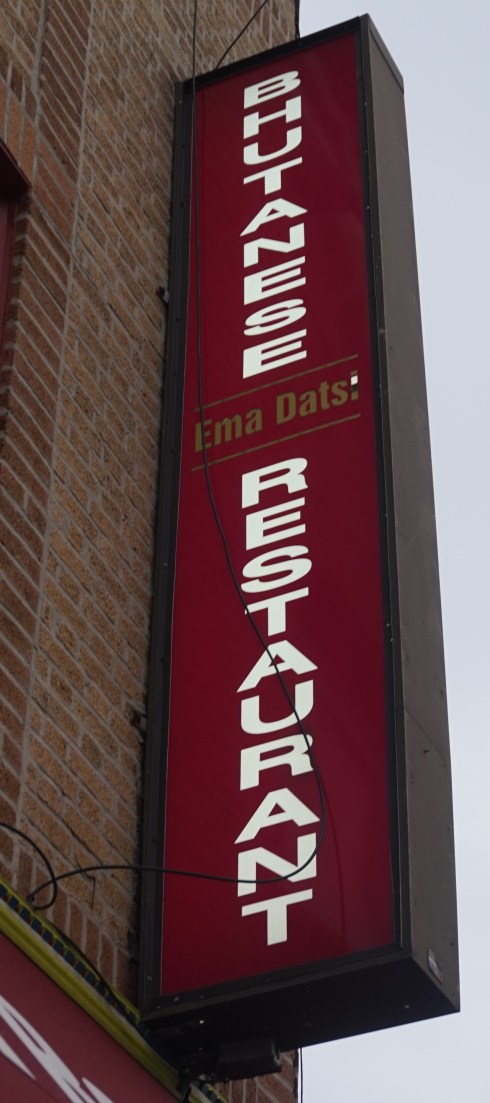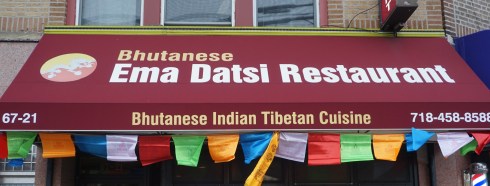 Little did we know when we first visited Woodside Avenue in the fall of 2015 and the Filipino karaoke joint, Papa’s Kitchen (Papa’s Karaoke in the Kitchen Blues) that we would return again to this now fabled food boulevard two more times within the same year. We had no idea that there were three food wonders—all within a two and a half block radius—on Woodside Avenue in our food group’ mecca: Queens. I should have picked up on the hint in Zio’s email after I announced Renacer Bolivian (A Beef Rebirth at a Bolivian Restaurant in Queens) as our last destination: “That was gonna be my pick,” he wrote. “I saw it just before we were accosted by the karaoke queen. I guess I’ll go with the Bhutanese place.”
Little did we know when we first visited Woodside Avenue in the fall of 2015 and the Filipino karaoke joint, Papa’s Kitchen (Papa’s Karaoke in the Kitchen Blues) that we would return again to this now fabled food boulevard two more times within the same year. We had no idea that there were three food wonders—all within a two and a half block radius—on Woodside Avenue in our food group’ mecca: Queens. I should have picked up on the hint in Zio’s email after I announced Renacer Bolivian (A Beef Rebirth at a Bolivian Restaurant in Queens) as our last destination: “That was gonna be my pick,” he wrote. “I saw it just before we were accosted by the karaoke queen. I guess I’ll go with the Bhutanese place.”
“Bhutanese?” I wasn’t paying attention until we filed out of Renacer and he pointed to the restaurant on the corner. “That place,” he said.
And a month later we were seated in Bhutanese Ema Datsi, the restaurant on the corner a few doors down from Renacer Bolivian and across the street from Papa’s Kitchen. The restaurant was deserted and the limited decor featured panoramic posters of villages tucked into Himalayan mountain tops. The menu was separated into three cuisines: Tibetan, Bhutanese, and Indian. Why go to a Bhutanese restaurant and order Indian food? None of us did. In fact, only Mike from Yonkers veered from the intriguing Bhutanese column on the menu when he ordered the Tibetan beef with oyster mushrooms.
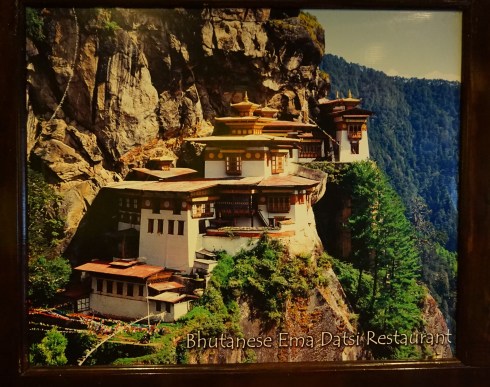
A Bhutanese retreat
We were without Eugene this evening meaning, because of his bizarre aversion to fungi, we were without guilt in ordering dishes with a plethora of mushrooms. Not that it would have stopped Mike from Yonkers—or Gerry for that matter—from indulging in the options on the Bhutanese menu. Gerry’s mushroom selection was the specialty of the restaurant, the ema datsi with mushrooms; a stew of vegetables along with the mushrooms and very hot green chilies combined in a mild gooey cheese sauce that was nothing like what you would get on a Philly cheese steak sandwich.
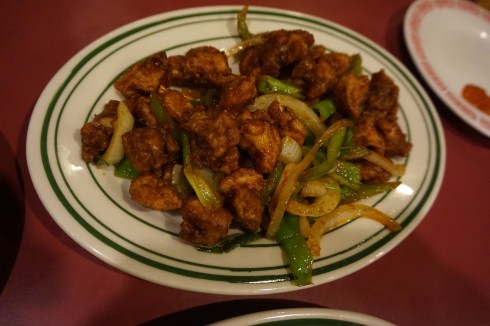
“Dry” pepper chicken
Before ordering our entrees, however, we got started with two appetizers: the “pepper chicken dry,” a fiery plate of stir fried boneless chicken and peppers, and the sooji deep fried pomfret (fish).
“What’s a pomfret?” Zio inquired of our gracious, yet soft spoken to the extreme, waiter. Could it be that he was fresh off a vow of silence stint at a Buddhist monk training camp? No one knew for sure, but the words he mouthed after Zio’s question were inaudible to all of our aged ears. When the pomfret arrived looking like slightly upscale fish sticks we quickly sampled. One taste and all of us agreed that the pomfret tasted suspiciously like tilapia—as if tilapia has any taste at all. Thankfully the fish was served with a house made chili sauce which gave it much needed flavor.
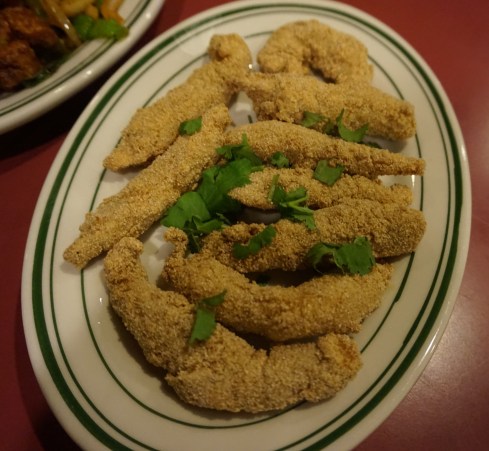
Bhutanese fish sticks
Zio and I choose “dry” items on the menu. He went with the dry pork and I tried the dried beef curry “moapa” style. Zio’s appeared first; slices of dried fatty pork belly in a stew of thinly sliced potatoes. “No these aren’t potatoes,” Zio proclaimed after taking a bite. I sampled one. “It’s a radish, ” I told him
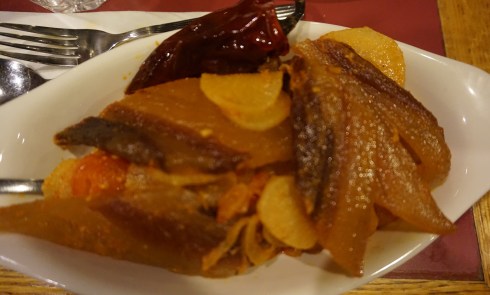
Dried pork
The potato like chunks in my dried beef stew were indeed potatoes but the stew was devoid of the familiar flavor of curry. Not that it mattered; the dish was hearty and fiery enough to sustain a man on a frigid night in the Himalayas. I wondered why the waiter deposited toothpicks on our table along with our platters until I began picking pieces of the dried beef out of my teeth.

Dry beef stew “moapa” style
Lastly, small bowls of from what I thought the waiter whispered was “seaweed soup” were given to all of us. I took a sip. I had heard correctly. Zio, however, heard nothing.
“I’m not sure if I’m supposed to clean my hands with what is in this bowl or eat it?”
Where do they get seaweed in Bhutan, I wondered aloud. No one answered. No one cared. Sometimes we need to put our heads down and just eat.
After cleaning our platters, our check arrived. We thought we might be helpless without Eugene present to tally up the damage. But there was no damage. We were well below our $20 per person allotment. And for all the very satisfying food we ate, that was a wonder in itself.
Bhutanese Ema Datsi
67-21 Woodside Ave
Queens
